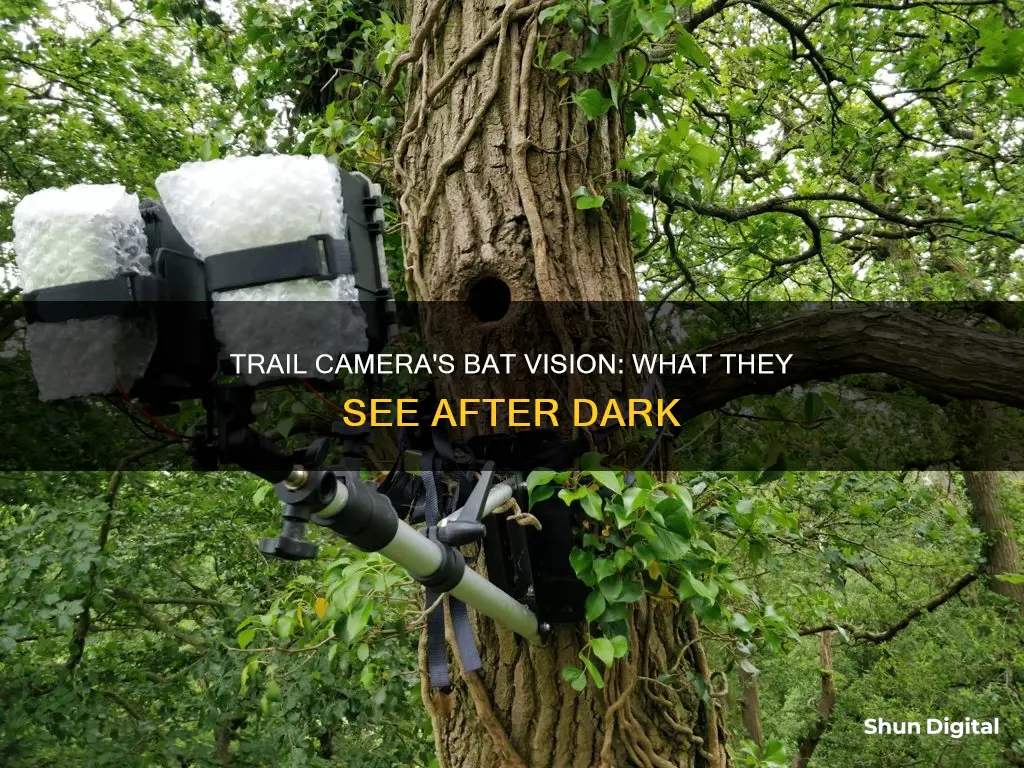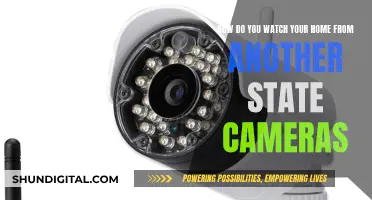
Bats are fascinating creatures that play a crucial role in our ecosystem. From pollinating plants to inspiring technological innovations, they are much more than just creatures of the night. If you're interested in learning more about these winged mammals and their secretive habits, a trail camera might be your best bet. These cameras are designed to capture the secret lives of bats, allowing you to observe their behaviour up close and in their natural habitat. But with so many options available, how do you choose the right one? This guide will take you through the features to look out for, the best camera models, and the ideal setup for capturing those high-quality bat photos or videos.
| Characteristics | Values |
|---|---|
| Difficulty of capturing bats on camera | Bats are difficult to capture on camera due to their small size and nocturnal nature. |
| Recommended camera features | Invisible night vision, compact size, waterproof, wide-angle lens |
| Types of cameras | Wired, wireless, acoustic trigger, continuous recording |
| Example camera models | Spypoint Force Dark, Cognisys Sabre, Nikon D800, Reconyx PC900, Bushnell, Cuddeback, Panthercam |
| Power source | External battery (e.g., 18650 batteries) |
| Lighting | Low-glow or glow-free infrared LEDs, flash |
| Cost | Approximately £230 for the camera and equipment |
What You'll Learn

The best camera traps for bats
Camera trapping bats is challenging because they are small, fast, and often active at night. Bats are such small infrared targets that they are rarely detected by the PIR sensors that trigger standard trail cameras. However, several camera traps have been found to be effective in capturing bats.
Bushnell, Cuddeback, and Reconyx
Several researchers have found the Cuddeback camera trap to be effective in capturing bats. One researcher has been using it for a year and a half and has captured several bat pictures. They suggest opting for the white flash version instead of the infrared one for clearer pictures, regardless of lighting conditions.
Another researcher found that the Bushnell camera trap produced good video quality. They also recommend the Panthercam for clear pictures of bats and the Reconyx PC900 for its image quality. However, they note that bats need to be within 2 meters of the camera to be captured.
Spypoint Force Dark
The Spypoint Force Dark cameras have the shortest trigger time on the market and 'no-glow' LEDs, which reduce potential disturbance to the bats.
Cognisys Sabre
The Cognisys Sabre is a camera trigger that can be used to capture bats. It controls both the camera and flashes. One user paired it with a Nikon D800 camera and four Nikon SB800 flashes.
Belfry Bat Detector
The Belfry Bat Detector is an acoustic bat sensor that can be used to trigger a DSLR trail camera setup. It has both LED and speaker jack options.
DSLR Camera Trap with Acoustic Trigger
One user set up a DSLR camera trap with an acoustic sensor and trigger to capture bats in their backyard. They used a Canon60D DSLR with a remote shutter release and PixelSoldier transmitter for remote flashes, and four Nikon SB-28 xenon flash units with Pixel Soldier wireless receivers.
Other tips
- Bats are attracted to nectar sources, colonies, and water sources, so placing your camera near these locations may increase your chances of capturing them.
- Using an acoustic trigger can be more effective than a PIR sensor because bats emit intense ultrasonic sounds for echolocation, which can be easily detected by an acoustic sensor.
- When using a flash, be careful not to overexpose the photo. You can use electrical tape over part of the flash bulbs to reduce the amount of light.
- If you need to capture bats at a closer range, you may need to modify the lens of your camera.
Hacking CC TV Cameras: A Step-by-Step Guide
You may want to see also

How to set up a trail camera to capture bats
Trail cameras can be used to capture bats, but it is challenging due to their small size and the fact that they are rarely detected by PIR sensors. However, with the right equipment and setup, it is possible to successfully capture photos and videos of bats using a trail camera. Here is a guide on how to set up a trail camera to capture bats:
Choose the Right Camera
Select a trail camera with a fast trigger time to increase the chances of capturing bats in motion. Look for cameras with "no-glow" LEDs, which will reduce potential disturbances to the bats, such as the Spypoint Force Dark camera.
Power Source
Standard AA batteries or lithium-ion battery packs may not provide enough power for extended periods. Consider using an external battery pack with 18650 batteries, which can power the camera for several months. Ensure you purchase high-quality batteries from a reputable source.
Mounting the Camera
Use a wall-mounted boom arm, such as the PIXAPRO, to securely install the camera outside the bat roost. Fix the camera in position using ratchet straps. You can also use flash brackets to make final adjustments and ensure the camera is in the perfect spot.
Acoustic Trigger
Bats emit intense ultrasonic sounds for echolocation, which can be detected by an acoustic sensor. Use an acoustic bat sensor like the "Belfry Bat Detector" to trigger the camera when bats are present. This will increase the chances of capturing bats in the frame.
Lighting
Bats are active at night, so consider using a flash to illuminate the area and capture clear images. Set up multiple flashes around the camera to provide even lighting and reduce recovery time between flashes. Alternatively, you can use a continuous infrared light source to illuminate the area without startling the bats.
Camera Settings
Use a DSLR camera with a remote shutter release and set it to “Bulb” mode to keep the shutter open for longer exposure times. Adjust the focal length, aperture, ISO, and shutter speed according to the distance of the bats and lighting conditions. You may need to experiment with different settings to find the optimal configuration.
Positioning
Position the camera close enough to the bat roost or flight path to avoid false triggers from moving branches. Place the camera near a water source where bats come to drink or where insects are abundant to increase your chances of capturing bat activity.
Legal and Ethical Considerations
Always prioritize the welfare of the bats and be aware of any restrictions on photographing bats in your area. Some jurisdictions may require a license for bat photography or have specific guidelines to protect their habitats, nesting areas, and feeding activities.
Apple Watch Series 4: Camera-Equipped Timepiece?
You may want to see also

Using trail cameras to survey bats in trees
Trail cameras can be used to survey bats in trees. Here is a list of equipment that can be used for this purpose, which should cost you about £230.
Camera
The Spypoint Force Dark camera has the shortest trigger time on the market and also features 'no-glow' LEDs, which reduces potential disturbance to the bats. This camera can be purchased from Camera Centre UK for £145.
Power source
An external battery is required to power the camera for several months. LG MJ1 – 18650 Battery – 3500mAh – 10A batteries can be purchased from UK stores such as NuBattery for about £7 per battery. Three batteries in series are required to power the camera.
Mount
To install the camera outside the roost, a PIXAPRO wall-mounted boom arm can be used, which costs £44. Two ratchet straps are needed to fix the camera in position, costing £8 for two. Flash brackets can be used on top of the mount for final adjustments, costing £10.
Other considerations
To avoid false triggers from moving branches, the camera should be positioned quite close to the roost entrance. For woodpecker holes, a distance of 40cm seems to work well.
Zmodo Cameras on Fire Stick: Easy Viewing
You may want to see also

The benefits of bat-watching
Bats are fascinating creatures that play a crucial role in maintaining a healthy ecosystem. Watching bats can be an enjoyable and educational activity that offers several benefits. Here are some reasons why you should consider bat-watching:
Understanding the Importance of Bats
Bats are often misunderstood and feared due to their nocturnal nature and association with darkness. However, bat-watching can help dispel myths and misconceptions by providing an opportunity to learn about their behaviour and ecological significance. For example, bats are primary predators of night-flying insects, including pests that can cause crop damage. By consuming these insects, bats save billions of dollars annually in pesticide costs and reduce the need for harmful chemicals in the environment.
Supporting Conservation Efforts
By participating in bat-watching activities, you can contribute to conservation efforts. Many bat species are endangered or threatened due to habitat loss, human disturbances, and the spread of diseases like white-nose syndrome. Your interest in bat-watching can help raise awareness about the importance of protecting bats and their habitats. Additionally, some bat-watching tours and events donate a portion of their proceeds to local wildlife conservation programs, ensuring the protection of bat colonies for future generations.
Experiencing Nature and Promoting Eco-Tourism
Bat-watching provides a unique opportunity to connect with nature and experience the magic of wildlife first-hand. It encourages people to explore natural habitats, such as caves, trees, and freshwater bodies, fostering an appreciation for the environment. Bat-watching tours and events also promote eco-tourism, benefiting local communities and economies. The famous Congress Avenue Bridge in Austin, Texas, for instance, attracts thousands of visitors from around the world who come to witness the emergence of millions of bats each night during spring and summer.
A Fun and Educational Activity
Bat-watching is a fun activity that can be enjoyed by people of all ages. It combines entertainment with education, making learning about nature engaging and accessible. Bat-watching tours often provide informative narration, offering insights into bat behaviour, migratory patterns, and their ecological benefits. Additionally, bat-watching can be a social activity that brings people together, creating a sense of community among enthusiasts.
Enhancing Your Knowledge with Technology
Bat-watching can be enhanced by using technology such as bat detectors, which allow you to hear bat calls that are inaudible to the human ear. These devices connect to phones and tablets, helping you identify different bat species based on their unique calls. Binoculars and red lights can also improve your bat-watching experience, providing a clearer view of bats while minimizing disruption to their behaviour.
In conclusion, bat-watching offers a range of benefits, from supporting conservation efforts and promoting eco-tourism to enhancing your knowledge and appreciation of nature. So, whether you're a nature enthusiast, a photographer seeking the perfect shot, or a family looking for an educational activity, consider embarking on a bat-watching adventure to discover the fascinating world of these misunderstood creatures.
Monitoring Remote Areas: Camera Surveillance Techniques
You may want to see also

How to attract bats closer to a camera
Bats are fascinating creatures and the only mammals capable of true flight. They can eat up to 1,000 insects an hour, providing natural pest control and pollination. Here are some tips to attract bats closer to a camera:
Install a Bat House
Bat houses are a great way to attract bats to your property and provide them with a safe space to roost and raise their young. You can build your own or purchase one, like the BatBNB, which is made from sustainably sourced cedar and provides a space that mimics bats' natural habitat.
When installing a bat house, consider the following:
- Positioning: Mount the bat house on a building or large structure, rather than a pole or tree. It should be 12-20 feet above the ground and receive at least six hours of daily sunlight.
- Proximity to Water: Bats need an unobstructed "swoop zone" to drink water safely, so ensure there is open water with a clear 7-10 foot area free of obstructions.
- Grouping: Bats are more likely to move into roosts grouped together, so consider installing multiple bat houses in different places.
Provide Water and Food Sources
Bats need water, and they hydrate by swooping down to the water surface to drink while flying. In addition, growing native plants will attract insects that entice hungry bats. Avoid using pesticides, as these harm bats and reduce their food sources.
Leave Dead Trees
If possible, leave dead trees in your yard, as they provide ideal roosting locations for bats. The narrow, rough space between the bark and the wood offers a tight squeeze for bats to feel secure.
Use a Suitable Camera
When setting up a camera to capture bats, consider using a trail camera with a short trigger time and 'no-glow' LEDs, which won't disturb the bats. Ensure the camera has a suitable power source, as batteries may not last long. External batteries, such as 18650 batteries in a battery pack, can provide power for several months.
By following these tips, you can create a welcoming environment for bats and increase your chances of capturing them on camera.
Phillips Smart TV Camera: Where is it?
You may want to see also
Frequently asked questions
It is challenging to capture bats on camera as they are small and fast-moving. The best cameras for capturing bats are those with a short trigger time and 'no-glow' LEDs, which will reduce disturbance to the bats. Some recommended camera models include the Spypoint Force Dark, Cognisys Sabre, Nikon D800, and Bushnell.
Trail cameras can be used to determine if bats are using a bat house or roost, test bat exclusions, and survey potential roosts or hibernation spots. They can also help identify bat species and understand their behaviour.
When setting up a trail camera to capture bats, consider the following:
- Use an external power source such as a battery pack to ensure the camera can run for several months.
- Position the camera close to the target area to avoid false triggers.
- Use a wide-angle lens to capture more detail.
- Ensure the camera is waterproof and protected from the elements.
- Consider using an acoustic trigger to detect the ultrasonic sounds produced by bats for echolocation.







